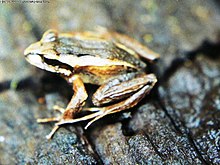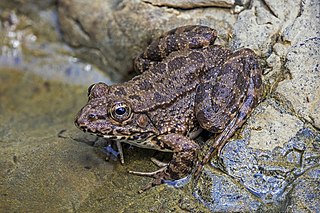
True frogs is the common name for the frog family Ranidae. They have the widest distribution of any frog family. They are abundant throughout most of the world, occurring on all continents except Antarctica. The true frogs are present in North America, northern South America, Europe, Africa, and Asia. The Asian range extends across the East Indies to New Guinea and a single species has spread into the far north of Australia.
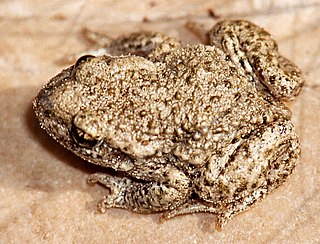
The Alytidae are a family of primitive frogs. Their common name is painted frogs or midwife toads. Most are endemic to Europe, but three species occur in northwest Africa, and a species formerly thought to be extinct is found in Israel.
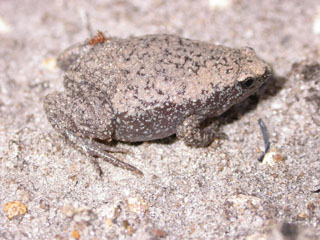
The Microhylidae, commonly known as narrow-mouthed frogs, are a geographically widespread family of frogs. The 683 species are in 63 genera and 11 subfamilies, which is the largest number of genera of any frog family.

Pseudacris is a genus of frogs in the family Hylidae found in North America ranging from the Pacific coastline to the Atlantic.

Alsodes is a genus of alsodid frogs found in Chile and Argentina. It is the most species-rich frog genus in Patagonia. Common name spiny-chest frogs has been coined for them.

Eupsophus is a genus of frogs in the family Alsodidae. They are sometimes known as ground frogs. The genus is endemic to Patagonia. Eupsophus is the second most species-rich frog genera of Patagonia. These frogs are restricted to forested areas at southern latitudes.

Pleurodema is a genus of leptodactylid frogs from South America. They are sometimes known under the common name four-eyed frogs, although this name can also refer to a particular species, Pleurodema bibroni. The common name is a reference to two inguinal poison glands that resemble eyes. When threatened, the frog lowers its head and raises its rear. When the frog adopts this posture, the poison glands are also raised toward the predator. The predator may also confuse the frog's raised posterior for the head of a larger animal.

Gastrophryne, the narrowmouth toads, is a genus of microhylid frogs found in the Americas between Honduras and southern United States. Its name means ‘belly-toad’, referring to its large belly, from the Ancient Greek gastēr and phrunē.

Dendropsophus is a genus of frogs in the family Hylidae. They are distributed in Central and South America, from southern Mexico to northern Argentina and Uruguay. They are sometimes known under the common name Fitzinger neotropical treefrogs or yellow treefrogs
Batrachyla fitzroya is a species of frog in the family Batrachylidae. It is endemic to Argentina and only known from its type locality, Isla Grande in Lake Menéndez, in the Los Alerces National Park, Chubut Province. The specific name fitzroya refers to Fitzroya cupressoides, a prominent tree at the type locality.
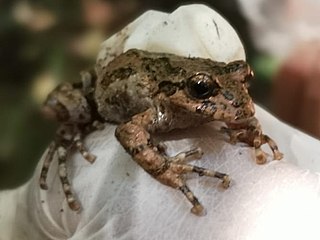
Batrachyla leptopus is a species of frog in the family Batrachylidae. It is found in Argentina and Chile. Its natural habitats are subantarctic forest, temperate forest, temperate shrubland, swampland, intermittent freshwater marshes, rural gardens, and open excavations. It is threatened by habitat loss.
Batrachyla nibaldoi is a species of frog in the family Batrachylidae. It is endemic to Chile and known from the Los Lagos and Aysén Regions between Villa O'Higgins in the south and Kent and Melchor Islands in the north; there is a record from Alao Island further north but this might represent Batrachyla taeniata. The specific name nibaldoi honors Nibaldo Bahamonde, Chilean marine biologist, in recognition of his "remarkable contribution to the development of the zoology in Chile". Common name Nibaldo's wood frog has been coined for it.

Batrachyla taeniata is a species of frog in the family Batrachylidae. It is found in Argentina and Chile. Its natural habitats are subantarctic forest, temperate forest, temperate shrubland, subantarctic grassland, temperate grassland, swampland, intermittent freshwater marshes, rocky shores, pastureland, rural gardens, and introduced vegetation. It is threatened by habitat loss.
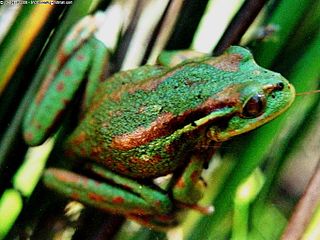
Hylorina sylvatica is a species of frog in the family Batrachylidae. It is monotypic within the genus Hylorina. It is found in Argentina and Chile. This species is endemic to the austral Nothofagus forests of Chile and Argentina with a narrow distribution along the eastern slopes of the Andes.

The Petropedetidae are a family of frogs containing three genera and 12 species. They are found in sub-Saharan tropical Africa and are sometimes known under common name African torrent frogs.
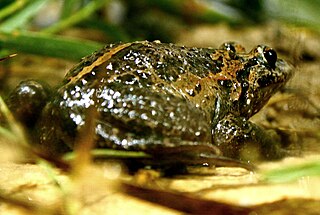
Latonia is a genus of frogs in the family Alytidae. It contains only one extant species, the Hula painted frog which is endemic to Israel and was originally classified in the genus Discoglossus, though several fossil species are known from the Paleogene and Neogene periods in Europe.

Batrachylidae is a family of frogs from southern South America. Before being recognized as a family, Batrachylidae was included as a subfamily (Batrachylinae) in the family Ceratophryidae; this is the taxonomy still suggested by the Integrated Taxonomic Information System (ITIS).

The Alsodidae are a small family of frogs from South America between Patagonia and southern Brazil. It contains 30 species in three genera. This family, along with several other families, used to be included in the family Leptodactylidae. It was then a subfamily in the family Cycloramphidae, before being recognized as a family first in 2011.

Dipsadinae is a large subfamily of colubroid snakes, sometimes referred to as a family (Dipsadidae). They are found in most of the Americas, including the West Indies, and are most diverse in South America. There are more than 700 species.
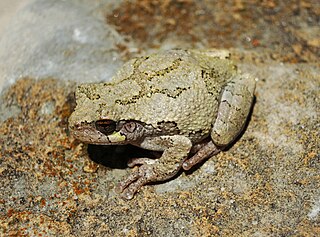
Dryophytes is a genus of Ameroasian tree frogs in the family Hylidae. They are found mostly in North America, but the genus also includes three species found in eastern Asia.
